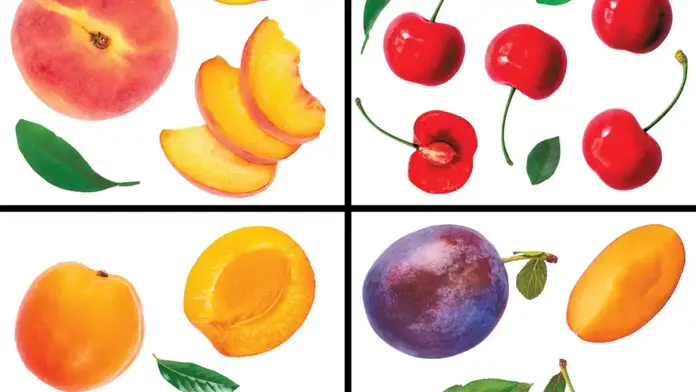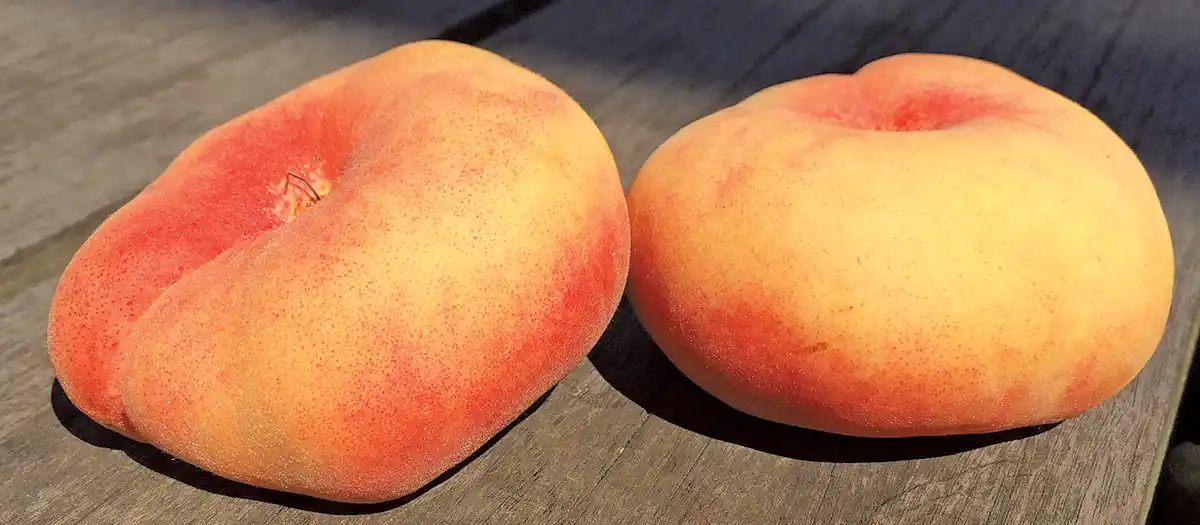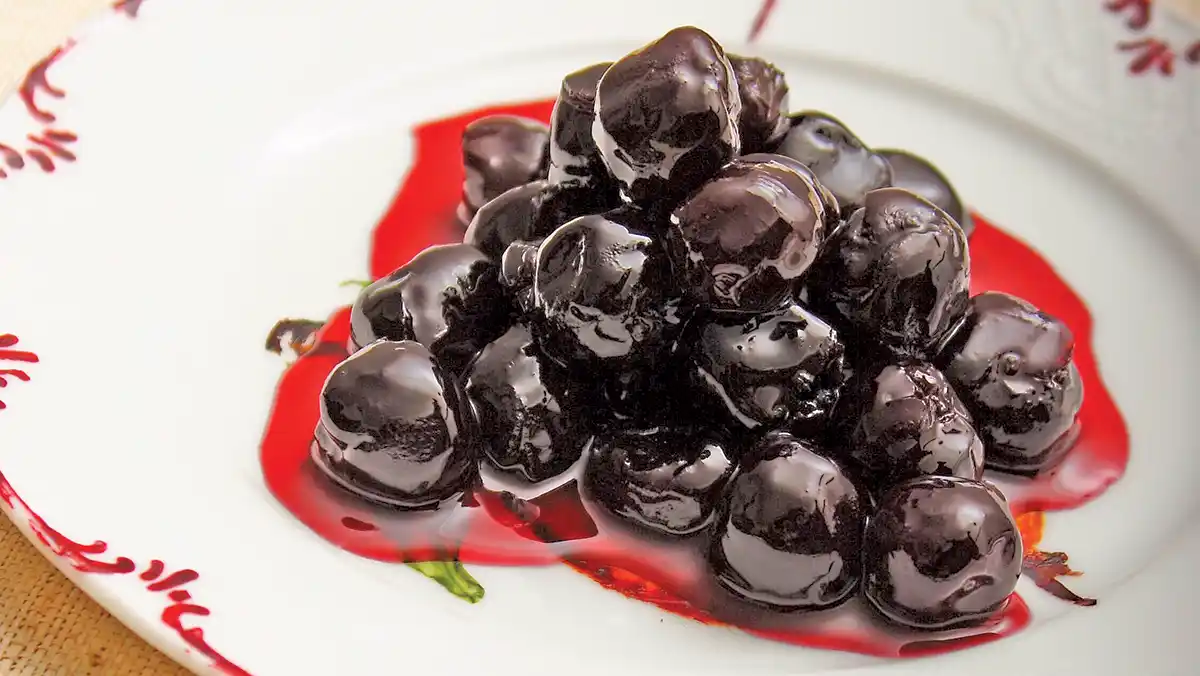
I absolutely love June – summer is nipping at my heels, most days we bask in a delightfully warm glow that reminds me of Greece, and finally, stone fruit season is upon us! Juicy peaches, tart cherries, succulent plums, sweet apricots – all ready to grace our respective cuisines with the culinary blessings of summer.
To me, summertime and stone fruits go hand in hand to bring about a deep sense of joy and nostalgia.
Romancing the Stone… Fruit
When I was a child, at the start of summer, as soon as the cherries ripened and turned perfectly scarlet red, my sisters and I would gently pluck the perfect twin cherries off the trees, so we could hang them on our ears to wear as earrings. With the single cherries, we would bite them half way, and then ‘apply’ our cherry lipstick. We would dance around, singing and laughing, pretending to be fancy with our dangling earrings and red lips.
My mother and Yiayia (grandmother in Greek) both found this ritual to be incredibly amusing, and would occasionally watch our ‘fashion show’ – but usually, they would ask us to collect the cherries for Yiayia’s incredible Glyka tou Koutaliou, traditional spoon sweets. My favorite of the ones yiayia made was Vissino, made from the sour cherries that grew in our backyard. During the summer, she would make a lot of these, so we could have them year-round.
The excess juice and syrup that resulted from making the sour cherry spoon sweets was also bottled, and called Vissinada. This magical cherry syrup was used to make an incredibly refreshing beverage with water (either sparkling or still) – I would crush the ice for the drink when I wanted to be fancy, but I loved it any way I could have it…I even used to put vissinada on our homemade ice cream and yogurt for a sweet treat.
My Papou (grandfather in Greek), on the other hand, taught me how to select a perfectly ripe piece of stone fruit every time, in particular peaches and apricots (though he told me the same applied to nectarines). He told me that I had to follow my nose – if I could smell the delicious scent of the fruit as I brought it to my nose, and could feel the supple firmness of its flesh – not too soft, but not rock hard either – then this piece of fruit would be the best I had.
Of course, Papou was always right, because once I learned that lesson, I never ate a mealy peach again! Papou also told me that eating these fruits would not only keep me healthy and strong during the summer, but that they would keep my belly from bloating and showing. As it turns out, he was right again, because stone fruits are full of fiber – but remember to always ask your doctor about incorporating it into your diet regularly….
Growing up with stone fruit all around me, it’s hard to imagine that these species weren’t always part of Greece’s landscape, but that’s not completely true.

Origin Stories
Peaches originated in China, estimated to first have been cultivated around 6000 BC, made their way through Japan and Korea, towards Asia Minor and Persia, and reached Greece around 400-300 BC. Alexander the Great is sometimes credited with having introduced peaches to Greece after conquering Persia. According to certain ancient traditions, peaches represent the fruit of purity and immortality.
Cherries originated in Anatolia, also known as Asia Minor, a large peninsula in Western Asia. They were found in the fertile lands between the Black and Caspian seas, likely brought to Europe by birds. Cherries were first mentioned in the book, History of Plants by Theophrastus, an early Greek botanist and protégé of Aristotle, in the 3rd century BC. Cherries were known to the Greeks, who cultivated them for many centuries.
Plums have a similar history, as the divergent species originated both in China and Japan, and simultaneously in Eastern Europe / Western Asia thousands of years ago. The cultivation of plums has been done since prehistoric times, longer perhaps than any other kind of fruit except the apple. The plum arrived in Greece around 400 BC after the Greek Persian war and quickly gained popularity as it spread rapidly throughout Europe and beyond.
Apricots were cultivated in China and Central Asia as early as 2000 BC and migrated with the country’s traders, who traveled the Great Silk Road. Like the peach, apricots were introduced to Greece by Alexander the Great. In Greek mythology, apricots were believed to be “golden apples,” and grew in the Garden of the Gods in the nymphs Hesperides’ realm, near the Atlas Mountains, where the nymphs tended the garden, protecting an apple tree gifted by Gaia. Legend has it that the retrieval of the golden apples was one of the Twelve Labors of Heracles (Hercules).
A Prunus for All of Us
All varieties of stone fruit come from the genus Prunus, indicating the stone ‘pit’ at the center of the fleshy fruit. Also known as ‘drupes,’ stone fruits tend to have thin skins that can be either fuzzy or smooth. The pit itself is actually a large seed, and stone fruits can be either ‘clingstone’ or ‘freestone,’ depending on how easily the flesh pulls away from the seed.
What’s truly amazing is how incredibly good for you stone fruits are!
Most if not all stone fruits offer highly impressive nutritional profiles, full of essential vitamins, minerals, fiber, and perhaps most importantly, phenolic compounds known as antioxidants (similar to those found in extra virgin olive oil), meaning that stone fruits may offer protection against heart disease, neurodegenerative conditions, diabetes, and certain cancers.
Additionally, many stone fruits are dried for consumption, which have additional health benefits, such as plums becoming prunes, which are an excellent natural resource for aiding in bowel and bone health.
It’s important to remember that dried stone fruits are much more calorically dense than ripe fruit, and though easy to eat, can also add extra calories and fiber to your daily diet, which can sometime have unwanted effects – be sure to ask your doctor.

Not Your Average Stone Fruit
Though it’s virtually impossible not to love at least one variety of stone fruit, what makes this group of produce so special is the culinary versatility it lends.
The physical structures and countless varieties of peaches, plums, apricots, and nectarines all lend themselves not only to sweet dishes, but many savory ones as well!
Grilling stone fruit is a delicious way to take advantage of the bounty of the season. Heating fruit draws out the juices, elevates aromas to new levels, and intensifies the sweetness through caramelization—all of which are perfectly paired with a hint of smoke from the grill. Just don’t forget to coat the cut, fleshy side of the fruit and your grill with some fat, to prevent sticking, as those sugars from the fruit love to cling to the grill.
Poaching stone fruit is another heated method that always yields delicious results, and can be served hot or cold, infused with herbaceous notes, or enjoyed completely sweet.
Use sliced or diced stone fruit to add a bright and sweet note to salads and cold preparations, balance light and bright summer sauces, or garnish your favorite appetizer. Pair with a pungent cheese for the ideal savory/sweet balance on a cheese board, or let the vivid flavors elevate a charcuterie platter. Make a cold and refreshing summer soup, like a nectarine gazpacho, or allow cherries to enliven your preferred animal protein.
It’s worth mentioning that if you cannot find quality stone fruit – either during or after the season – there’s no harm in using canned fruit or purees, as long as they are packed in water or natural juices. One of my favorite brands that I use when fresh fruit isn’t available is Christodoulou Bros. from Greece – their quality is excellent, and they capture the fruit at the peak of ripeness to get the best out of it! I particularly love their canned peach halves, and their purees of black cherry, organic apricot, and plum – unlike anything I’ve encountered in the US to date.
So, no matter how you choose to incorporate stone fruit on your menu, remember that the season is short – yet bountiful – and with proper care and planning, you can enjoy these flavors all summer long, and into the cooler months to elicit the nostalgic flavors of summer.
Peach Salad with Loi Feta-Yogurt Pougi
Serves 4
Ingredients – Salad:
2 firm-ripe peaches
Greek extra virgin olive oil, for grilling
Salt and freshly ground pepper
12 ounces of Arugula
4 heaping tablespoons of Loi Feta-Yogurt Pougi
Ingredients – Dressing:
6 tablespoons Greek extra virgin olive oil
6 teaspoons of organic wild honey
½ lemon, juiced
½ teaspoon lemon zest
Salt and freshly ground pepper to taste
Directions:
1. Wash, dry, and halve peaches to remove the pit, keeping the skin on.
2. Brush peach halves with olive oil, and season lightly with salt and pepper.
3. Grill flesh side down over medium-low heat for approximately 1-2 minutes, until peaches soften slightly and grill marks are noticeable as the natural sugars caramelize; remove from the grill, and reserve skin side down/flesh side up on a plate.
4. Combine salad dressing ingredients in a small mixing bowl, whisking to fully combine.
5. Add arugula to a large mixing bowl, season lightly with salt and freshly ground pepper, and toss gently with 5 tablespoons of dressing.
6. To serve the salad, divide arugula evenly into four separate bowls, placing grilled peach half in the center of the arugula bed. Top each peach half with 1 heaping tablespoon of Loi Feta-Yogurt Pougi in the center, and drizzle each salad with remaining dressing – enjoy!

























